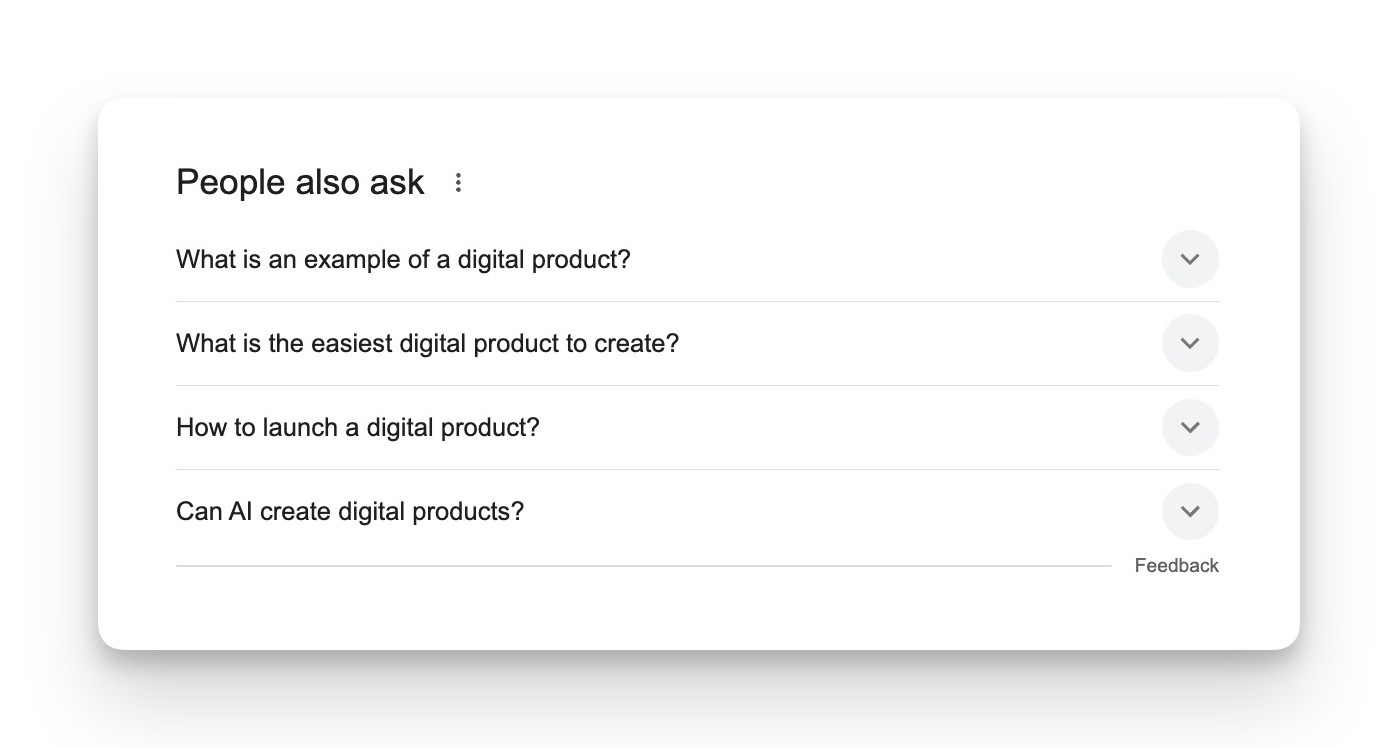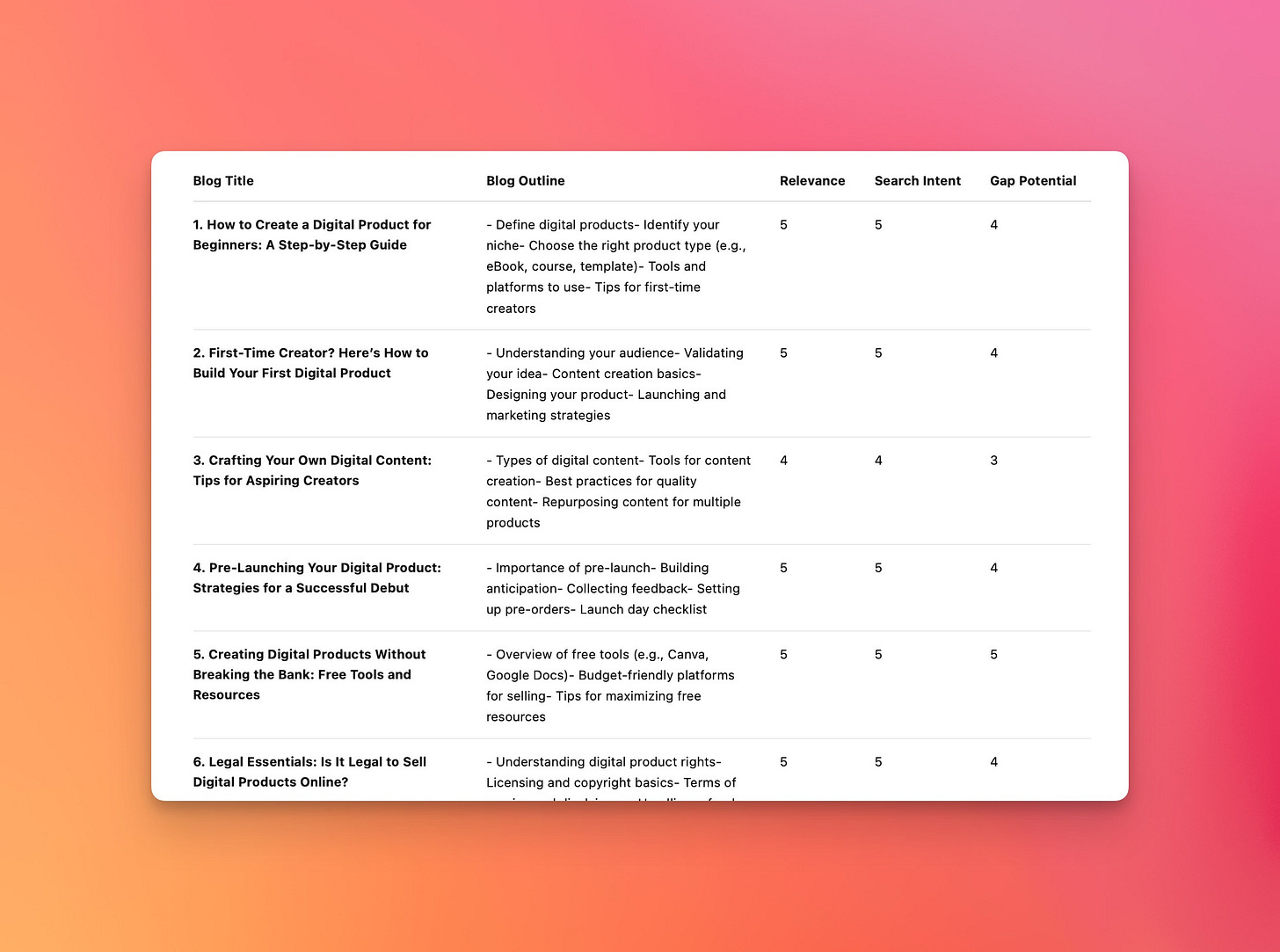How to Leverage “People Also Ask” to Generate Content Ideas for Your Newsletter
Learn how to use Google’s “People Also Ask” feature to uncover real questions, fill content gaps, and boost your SEO visibility effortlessly.
Access your FREE Solopreneur Success Hub - your subscribers-only comprehensive command center for building and scaling a successful one-person business.
I created this all-in-one toolkit for building a profitable one-person business, something I wish existed when I first started, and it saves me 20+ hours a week.
Now, it’s yours. No Opt-In Required.
More information about the Hub here.

Creating content consistently on Substack can feel like trying to fill a bottomless cup.
Everyone’s talking about A.
Everyone wants B.
But what should you write this week?
Cue: Google’s “People Also Ask” (PAA).
This under-the-radar gem can become your #1 source for hyper-relevant content ideas, directly inspired by what your future readers are already searching for.
It’s fast, free, and wildly powerful.
This guide will show you exactly how to use PAA to fuel your Substack with strategic, SEO-aligned content that pulls in the right audience and keeps them coming back.
Plus, towards the end of the post, I will also include a mega AI Prompt that you can use immediately to generate a 20 newsletter post title with useful metrics to get you started on your niche topics immediately!
Jump Straight To The Topic:
What Is “People Also Ask” and Why Should You Care?
“People Also Ask” (PAA) is a Google feature that shows a list of related questions people commonly search for based on your query.
Each question expands to reveal a brief answer (pulled from a website), and clicking on one reveals more related questions.
You’ve probably seen it without even thinking about it.
Search: “How to create a digital product”
And bam! You get:
What digital products sell the most?
How do I make my first digital product?
Do I need a website to sell digital products?
That’s real user data being handed to you.
Questions your ideal audience is asking right now.
Why it’s a big deal for Substack writers like us:
You don’t have to guess what your readers want to know.
You get infinite ideas (click a question and more appear).
You get keywords and structure all in one place.
You stay SEO-relevant by answering long-tail queries.
Why Use PAA for Substack Content on Digital Products?
Substack writers teaching digital product creation can benefit from PAA in ways that go beyond just idea generation.
🔍 Better SEO Visibility
Each question in PAA is basically a long-tail keyword.
If you write a post titled “How Do I Make My First Digital Product?” and structure it well, there’s a good chance you’ll rank for that exact question, possibly even get picked up as a featured snippet.
💡 Build Authority + Trust
By answering beginner questions, you’re showing empathy and expertise. You’re speaking their language, solving their problems—not throwing jargon at them.
🎯 Multiple Ranking Opportunities Per Post
PAA questions are often semantically linked. One post could target:
What platform should I use to sell digital products?
Do I need an email list before launching?
What are examples of low-cost digital products to create?
That’s multiple ranking chances with one newsletter.
Goldmine.
Step-by-Step: Use PAA to Find Killer Content Ideas
Ready to turn Google into your personal Substack researcher?
Let’s go.
1. Researching PAA Questions
Start with a simple seed keyword:
“How to create my first digital product”
Type that into Google and check out the PAA box. You might see:
What is an example of a digital product?
What is the easiest digital product to create?
How to launch a digital product?
Can Al create digital products?
Click one to see more.
Google dynamically loads more questions every time you click.
Keep going until you have 20–30 related questions.
Pro tip - You can also use these tools to make this easier:
These tools visualize question clusters so you don’t have to collect them manually.
2. Organizing and Clustering the Questions
Once you’ve gathered 20–30 questions, group them by topic or funnel stage.
For example:
Idea Phase
How do I come up with digital product ideas?
What kind of digital product should I create?
Creation Phase
What tools do I need to make a digital product?
How long does it take to make a digital product?
Launch Phase
How do I price my first digital product?
Can I launch a product without an audience?
Marketing Phase
How do I market my product on Substack?
What’s the best way to use email for digital sales?
This gives you the perfect skeleton for a content calendar or even a digital product creation series.
3. Selecting Questions That Actually Work
Here’s what to look for:
Relevance: Does it align with your newsletter content mission? Is this something you can research and write about?
Search Intent: Is it something your readers truly want to know, or just surface curiosity?
Gap potential: Are the current Google answers weak, generic, or outdated? Great! Fill that gap with your content!
Structuring Substack Posts Using PAA Questions
Here’s a framework that makes your post SEO-friendly and reader-friendly.
Use the Question as a Header
Let’s say your post is on creating your first digital product.
Your structure might be:
H2: What is a digital product and how do I make one?
Start with a short, direct answer. Think 1–2 sentences like Google does.
Then expand: add tools, pros/cons, steps, or examples.
H2: What tools do I need to create a digital product?
Bullet list tools like Canva, Notion, Gumroad, etc.
Add quick “use this if…” recommendations.
Add “Pro Tip” to enhance the reading experience
H2: Do I need a website to sell my digital product?
Answer directly: No, you can use Gumroad, Ko-fi, or even Substack itself.
Then add your personal workflow or beginner-friendly platform tips.
This layout checks the box for:
SEO
Skimmability
Reader satisfaction
Optimizing for SEO + Substack Discovery
SEO and Substack work together beautifully when done right.
Use Keywords in Strategic Spots
Long-tail keywords from PAA should appear in:
Your title
The first paragraph
At least one subheading
Your meta description (if you’re cross-posting on a blog or site)
Example Title:
“How to Create Your First Digital Product (Without a Website or Tech Headaches)”
Meta Description:
“Learn how to choose, build, and sell your first digital product even if you’re starting from scratch.”
Internal Link to Other Posts
Already written about tools or email lists?
Link them inside your post to build topical authority.
Example:
“Need help building an audience before launching? Check out this post on addressing your target audience pain points & showing how your product/ service is the solution.”
Make It Mobile-Friendly
Most Substack readers open newsletters on their phones.
Use:
Short paragraphs
Bolded headers
Bullet points
Clean, readable formatting
Advanced Tips & Tricks for Content Planning
Let’s level up.
Revisit PAA Regularly
Google updates PAA based on trends.
If you’re planning monthly content, revisit your seed keywords and update your ideas list.
Pair with Substack’s Discovery Engine
Use PAA content as a base, then:
Add Substack tags like “digital products,” “creator tools,” “online business”
Collaborate with similar newsletters for recommendations
Embed referral links or lead magnets inside value-packed PAA posts
📊 Track Performance
Use:
Substack’s built-in analytics
Google Search Console if you cross-post to a blog
Watch for:
Open rates
Click-throughs
New subs
Organic search impressions (if SEO is a goal)
Double down on the PAA-inspired content that performs best.
And Finally
If you’re a creator on Substack, Google’s “People Also Ask” might just be your secret weapon to understanding what the world is asking for in terms of content.
Here’s Why You Should Start Today:
💡 It removes guesswork from content planning
🔍 It shows you exactly what your audience is searching for
📈 It gives you a leg up in SEO and discoverability
🧠 It helps you structure smarter, more helpful posts
📅 It fuels weeks (or months!) of content ideas
So go ahead, search “your niche/ your newsletter topic”, open up that magical PAA box, and start pulling in real questions from real people who need your expertise.
And Now For The Mega AI Prompt
What This Prompt Does:
Targets real questions people are asking in PAA
Builds a table that mirrors the blog strategy model from the guide
Scores each idea across relevance, intent, and opportunity
Suggest 20 blog article titles that are SEO-optimized
Helps you prioritize content for high-impact newsletter growth
This Is What You Will Get
Mega Prompt Used:
Keep reading with a 7-day free trial
Subscribe to The Solopreneur Code to keep reading this post and get 7 days of free access to the full post archives.





